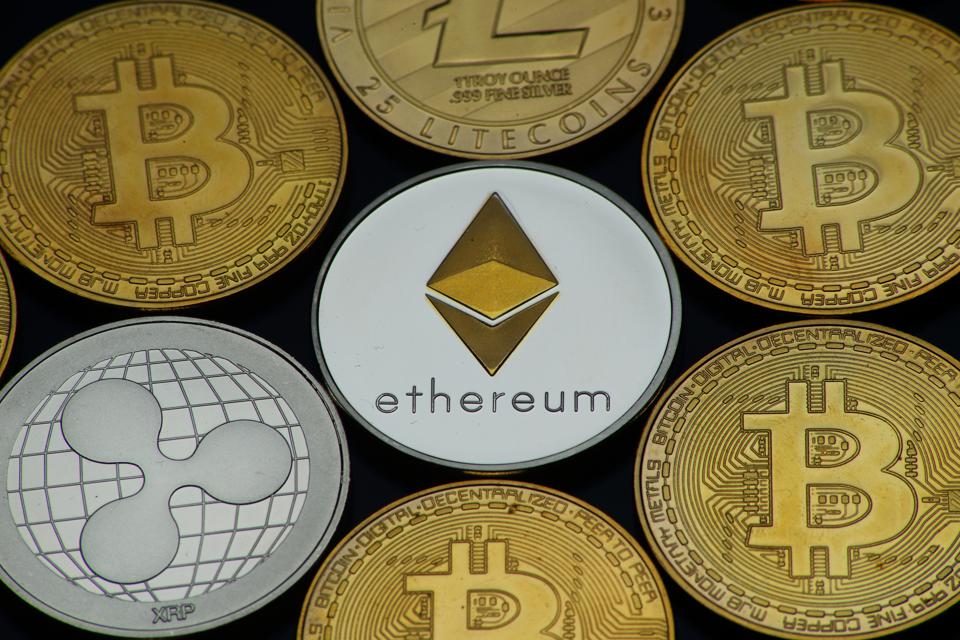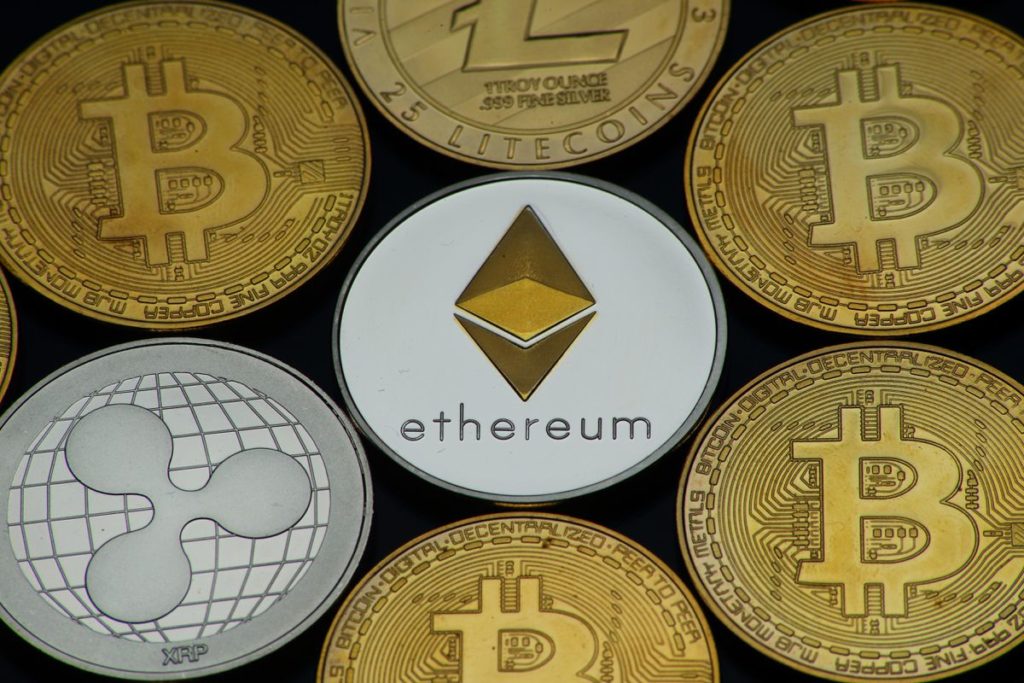
A visual representation of the cryptocurrencies Bitcoin, Ethereum, Litecoin and Ripple on November … [+]
Getty Images
Decentralized finance (DeFi) has come into sharp focus this year amid a cambrian explosion of products, massive interest, and plenty of busts. Perhaps the most underappreciated development, though, has been the relentless suck of bitcoin onto the Ethereum protocol via tokenized representations on the blockchain. From under 3,000 bitcoin tokenized in May to over 120,000 ($1.3 billion) today, the trend has been breathtaking, with no pause even during the volatility and market correction experienced by most DeFi tokens in September.
The most popular method by far of using bitcoin on the Ethereum blockchain is WBTC, or Wrapped Bitcoin, an ERC20 token with 1:1 collateralization offered by custodial and prime brokerage services provider BitGo. WBTC is a centralized, custodial, and KYC/AML compliant way to lock bitcoins under custody with BitGo, which then allows the minting (issuing) of new WBTC tokens via merchant partners which can be used to access DeFi protocols directly on Ethereum.
BitGo, the custodian for WBTC, is announcing today that they are adopting the newly released Proof of Reserve mechanism via the Chainlink protocol. In doing so, they are the first entity to use the novel functionality from the most utilized decentralized, tamper-resistant oracle provider. The announcement is a major win for DeFi in moving towards better transparency at a critical interoperable chokepoint where the tech for bridging certain gaps is still developing.
While the leader far and away in market share of tokenized bitcoin, comprising of 74% of the total bitcoin on Ethereum as of writing, WBTC has been criticized for the centralized nature of issuance and onerous compliance requirements, two key vectors at odds with the underlying ethos of the DeFi ecosystem. By adopting the newly unveiled Proof of Reserve contract specification from Chainlink, BitGo has taken a major step in providing easily accessible and automated audit functionality. The DeFi native, transparent, and verifiable Proof of Reserve mechanism will help increase confidence in the WBTC product for many that want to use it in decentralized applications.
[Ed note: Investing in cryptocoins or tokens is highly speculative and the market is largely unregulated. Anyone considering it should be prepared to lose their entire investment.]
At its heart, Proof of Reserve is a way to perform automated, trust-minimized on-chain auditing of assets. While it may sound underwhelming at first, the use of Proof of Reserve has massive implications across the entire crypto industry, and potentially traditional finance as well. Says Sergey Nazarov, co-founder of the Chainlink protocol “I think the concept of Proof of Reserve generally is really about proving that an underlying asset somewhere is in a certain state. And that proof is actually very fundamental to how financial systems work. So for example the 2008 financial crisis, the way that financial crisis came about was there was a disconnect between the actual underlying value of an asset and [the market]. That disconnect [lead to] a large financial crisis, but it also made various other collateral like mortgages difficult to be used. So what Proof of Reserve does is it makes a form of collateral much more bulletproof.”
He continues “If there is another market correction like 2008, it will be around the solvency and the underlying value of assets and the proof of that. And then a system like Proof of Reserve will become very in demand, in my opinion, because it will be a system that can prove to people that their underlying assets are consistently in a certain state.”
Although focused on tokenized bitcoin initially, Nazarov is aware of the wider implications for what Proof of Reserve could mean by lowering risks and providing better information around much of the collateral used in both crypto and traditional financial markets. “I think this is a larger trend of how oracles relate to generating collateral. And collateral underpins a lot of DeFi and a lot of the ability to generate interest. Now this Proof of Reserve system together with WBTC is actually a very exciting initial implementation of something larger. This is where Proof of Reserve can really expand to generate for people proof about various collateral in a way that makes it useful for DeFi.”
While BitGo is one of the first to bring bitcoin to Ethereum, they are far from the only product on the market these days. Other offerings such as Synthetix’s sBTC, Ren’s renBTC and Keep’s tBTC (among other smaller or still nascent players) all offer more foundationally decentralized mechanisms either via fully synthetic representations (in the case of sBTC) or trust-minimized collateralization (renBTC and tBTC). One competitor in particular, tBTC, has been hotly anticipated by the market, but was forced to pause new deposits in May after running into a contract bug early in the initial public release phase. However, they just announced as of last week that they are resuming deposits on a limited basis, and will be scaling up deposit caps over the next few weeks a la the Ken Deeter ‘Guarded Launch’ approach.
That being said, up until this point no competitor has been able to capture significant market share and users looking to utilize bitcoin as collateral for DeFi have clearly shown a preference for using WBTC. The significance of BitGo’s choice to utilize Chainlink and the Proof of Reserve contracts they have developed hasn’t gone unnoticed by Nazarov. “The largest cross-chain asset out there is publicly going to be relying on this to create assurances for their user base that this is a reliable asset.”
How It Works
In order to ensure the veracity of BitGo’s reported numbers, Chainlink nodes will query the balance at BitGo’s custodial Bitcoin address every ten minutes (to coincide with the mining of new bitcoin blocks). The querying will be done off-chain, but any deviations as new assets are added and minted, or burned and redeemed, will trigger an on-chain update to the reference Proof of Reserve contract. In that case, any DeFi application offering products utilizing WBTC as collateral will receive real-time updates, and can write business logic ensuring that users of their platforms are within risk and margin limits, potentially requiring automated liquidations or refusing new business if necessary.
The Best Collateral In The World
Despite the gnashing of teeth and rending of garments from many Bitcoin maximalists, the desire to bring bitcoin onto the Ethereum network should come as no surprise, as the most definitively provably scarce, highly secure, liquid, and developed cryptoasset is in many ways the very best collateral available in the world. In an April blog post titled “BTC + DeFi = FTW”, Max Webster of VC firm Version One laid out the case for bitcoin’s role in the DeFi ecosystem. “Because of its impressive security and liquidity network effects, it’s not hard to imagine that Bitcoin’s ultimate killer app will be that of the most secure, liquid, bearer asset collateral in the world and thus the basis for a new financial system.” Due to the limitations (by design) of Bitcoin’s scripting language, however, the ability to use bitcoin in a wider range of applications outside of its already proven use case as a store of value has so far proven elusive.
What often goes underappreciated by even sharp thinkers in crypto and markets is just how massive and fundamental the role of collateral is in the global financial ecosystem. The global financial crisis of 2008 was a credit crisis, but what kicked it off was a liquidity crisis that began when the overnight collateral market for what is known as ‘commercial paper’ froze, leading to a cascade of liquidations from bad collateral. As a system like Proof of Reserve goes mainstream, the ability to trustlessly and transparently automate auditing of collateral could lead to much lower systemic risk, as credit lines are updated in real time. With the continued development of both smart contract and crypto technology, Bitcoin could be at the heart of that new, safer, more open and democratic system.
Sergey’s Vision
With Proof of Reserve, Nazarov has unveiled the third leg in what is an increasingly impressive product catalog. The first two, verifiable decentralized price feeds and proof of randomness, have allowed blockchain technology to move from a strictly two-dimensional, chronologically ordered proof of transaction world into a three dimensional Web3 world. Use cases for Proof of Reserve can now tie that back into the realm of what would be considered more traditional finance, recreating in a permissionless and censorship resistant way what used to be expensive, manual, error (and fraud) prone practices. Getting there hasn’t been an accident. Says Nazarov in excited bursts from behind an enormous coffee mug:
“What I think people don't fully see is that Chainlink is a new form of decentralized computation that opens up categories of definitive truth that blockchains don't traditionally do. Chainlink has an ability to provide proof about a multitude of things. It provides proof about price, it provides proof about randomness, in this case it provides proof about the solvency, accuracy, and trustless relationship between the bitcoin chain and the WBTC system that feeds bitcoin into DeFi to the benefit of bitcoin and to the benefit of DeFi. You can use an oracle network like Chainlink to achieve entirely new forms of trust minimized computation. And when you achieve those new forms of trust minimized computation, once you combine them with other existing forms like blockchain-based transaction proof computation, then those permutations generate new and interesting and important innovations and utility and use cases.
What we're actually doing, and you'll see this if you look at the bigger picture of what we're doing, is we're putting out more and more of these building blocks. We don't make DeFi products. Our entire point is how do you take this new form of trust minimized computation in the form of an oracle network, how do you turn it into these various building blocks like the price feeds, like on chain randomness, like weather data, in this case like proof of reserves, how do you prioritize those building blocks, and then how do you get those building blocks out and into use cases.”
While audacious, he and his team have certainly delivered. With partnerships across DeFi and traditional markets, the ground the Chainlink team has covered in a short time is nothing short of breathtaking. Against years of doubt, lack of interest, and ennui, they have continued to execute on the mission through it all. But sit with the young founder for even a few minutes and it’s clear he is far from satisfied. Passionate and full of energy, Nazarov has been quietly assembling one of the top teams in the space, with the hiring of famous cryptographic researcher Dr. Ari Juels to lead the newly formed Chainlink Labs research division just one recent high-profile example.
Certainly, questions remain. It will be a long, hard road to till before mainstream crypto adoption and many battles to fight in the interim. Technological, regulatory, and social hurdles are never far from the daily grind, but with the dedication shown so far, there is no doubt that Chainlink will continue to be an integral part of pushing the DeFi ecosystem forward.
Disclaimer: Rory is an active trader and investor holding positions in several cryptocurrencies as well as equities and other private investments at any point.


